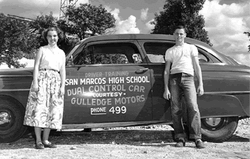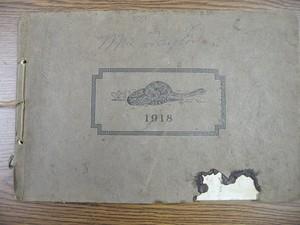- San Marcos Consolidated ISD
- Our History
History of San Marcos CISD
-
 In 1846, William W. Moon, the first settler in what became San Marcos, built a log cabin that served as a school, church and courthouse near present day Colloquium Books. For the next 20 years or so small private schools, tutors and parents would provide most of the education for the children.
In 1846, William W. Moon, the first settler in what became San Marcos, built a log cabin that served as a school, church and courthouse near present day Colloquium Books. For the next 20 years or so small private schools, tutors and parents would provide most of the education for the children.Then in 1868, the Coronal Institute, a Methodist High School, was built on the former site of the Lamar Annex. The school’s initial success was due to its healthy climate. Yellow fever epidemics were hitting the schools in the coastal regions and in East Texas. The 1869 Coronal Catalog stated that, “out of 300 students received into the Institute within the last three years, not one death has occurred, and there has been only one single case of serious illness.”
Coronal Institute closed December 21, 1918 for the Christmas vacation--the last student to leave that day was C.M. Maurice Waldrip, father of Charles Waldrip. The school failed to reopen in January, thus making Waldrip the last student of the Institute. In 1925 Coronal was sold to the San Marcos School District.
San Marcos High School was built on the block of Comanche and Hutchison across from the present Pennington’s Funeral Home. It was an elegant three-story red brick building. The last Rattler yearbook produced from this location was in the spring of 1940. The 1941 yearbook edited by J.M. Cape was produced from the Education Building located on Southwest Texas State campus.

In 1918 Southwest Texas Normal School (SWT) built the Education Building “intended in large part as a demonstration and laboratory school.” In 1939 the Auditorium-Laboratory School Building was completed by the college and all public school students, kindergarten through 6th grade, were housed there. By 1941 all the public school students were located on the college campus.
Patty Sherrill Sullivan entered first grade in the Education Building in 1933 and would graduate from there in 1944. Hers was the first class to go all the way from start to finish at the Education Building. Elementary grades were on the first floor; Junior High was on the second floor, and High School was on the third floor.
By 1949 the college and the public schools were bursting at the seams so the last of the Coronal Buildings were destroyed to build a new High School on the site. In the fall of 1951 the first students moved into the brand new school, which consisted of grades 10-12. In the fall of 1952, grades 9 through 12 were housed in the high school. Bonham Elementary opened in 1951, Travis Junior High School and Bowie Elementary opened in 1954, and Crockett Elementary in 1964. By 1965, all San Marcos Public Schools were gone from the Southwest Texas campus.
In the ensuing years, San Marcos CISD has continued to add new campuses. These include the present San Marcos High School on Highway 123, Hernandez Elementary School, and Goodnight and Miller Junior High Schools.
In 1911, Mr. Moore and Coach Woods set about to make us contenders and in 1912 the Rattlers “wiped up the ground with Austin High School.” In 1914 the Rattlers beat both Southwest Normal and San Antonio High School. The early Junior High School teams were known as the Trojans, and later as the Bull Dogs, but the High School team has always been called the Rattlers.
The history of education in San Marcos would be incomplete without mention of the selfless, dedicated men and women who devoted their lives to improving the lives of our children. Some members of this honor roll include Yancy P. Yarbrough, Mary Dodgen, Irma Bruce, Willie Higgs, Ed Lyons, Ruth Munk, Non Douglas Wray, Owen Goodnight, Thomas Yoakum, James Farmer, Bush Ewing and Gwen Smith.
This article appeared in Celebrate San Marcos 150!, published by the Daily Record & The Free Press, San Marcos, TX March 1,2001. Permission to reprint obtained from Cyndy Slovak-Barton, Associate Editor of The Free Press, on Oct. 6,2004 and Rowe Ray, Managing Editor of the Daily Record, on Oct. 5, 2004.

